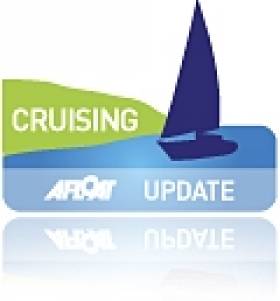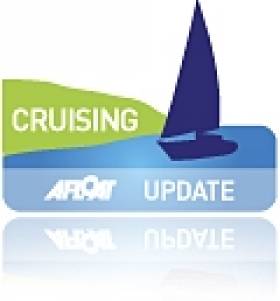Displaying items by tag: Jarlath Cunnane
Northabout crew from the Irish yacht’s historic polar circumnavigation marked the 80th birthday of their expedition skipper Jarlath Cunnane in Mayo last weekend.
The adventurer, boat builder and holder of the prestigious Blue Water Medal, was joined by fellow sailors and friends for the celebration in Castlebar.
Cunnane had requested “no presents, no cards, no speeches”, but friends did toast his eight decades at the event in Bar One in Castlebar.
Among those who attended were long-time fellow sailors Michael Brogan, Paddy Barry, Kevin Cronin, Colm Brogan, Galway hooker sailor Benen McDonagh, Seamus Breathnach, Rory Casey, Louis and Maeve Keating.
 Prestigious Blue Water Medal holder Jarlath Cunnane
Prestigious Blue Water Medal holder Jarlath Cunnane
Musician and sailor Matt Molloy was also present, along with Tom Moran, Gary Finnegan, Brendan Minish and partner Annie, Oliver Kellegher, Paul Gannon, Kevin Rowley, Mary Ryan and many other friends.
Cunnane has just embarked on building an Achill yawl, having previously completed his second replica of the James Caird, the lifeboat used by Ernest Shackleton and crew on their lifesaving voyage from Elephant Island to South Georgia to secure help for stranded Endurance crew in the Antarctic.
Cunnane’s second replica was a Covid lockdown project and he built it in memory of Scots carpenter Henry or Harry Chippy McNish, who was a member of the TransAntarctic Expedition 1914-1917 but was snubbed by “the Boss” when it came to recommendations for polar medals.
The second replica is now on display at the South Pole Inn in Annascaul, Co Kerry.
Cunnane has also recently published a revised edition of “Northabout”, the book he wrote about the yacht’s circumnavigation of the polar ice cap in a westerly direction.
In 2012, Cunnane and crew sailed the White Sea (Belomorsk) Canal.
In a review of the new edition for the Irish Cruising Club (ICC), Michael Brogan says the White Sea canal voyage “brought the crew face to face with the atrocities of Stalin’s notorious Gulag, a stark reminder of the direction Russia under Putin is now taking”.
“Russia is closed off once again, and this together with climate change, underlines the fact that "Northabout’s" circumnavigation will unlikely be repeated at anytime in the future,” Brogan writes.
He notes that Cunnane’s new edition also includes “cruises to the Caribbean, a mid-Atlantic rescue of a French couple from a sinking yacht, a cruise to Nova Scotia, Newfoundland and the story of the 1997 South Arís expedition to recreate Shackleton’s voyage from Elephant Island to South Georgia”.
“Despite Shackleton’s leadership qualities in saving all of the crew of the ill-fated Endurance, Jarlath portrays another side of Shackleton; his cavalier treatment of the crew of the "Aurora", and his refusal to recommend "Endurance’s" carpenter Henry Mc Nish for a polar medal,” Brogan writes.
He says that the new edition is “beautifully written and illustrated, and is highly recommended as an inspiration to all sailors and readers alike”.
“Northabout: Sailing the Northwest and Northeast Passage” is available to ICC members at a special price of €25.00 plus p&p directly from Jarlath email- [email protected]
It is also stocked in Charlie Byrne's bookshop in Galway at €30.00
Ice With Everything For The Sailing And Mountain Men Of Magnificent Mayo
“Seal meat tastes strong and is best eaten, we found, with plenty of onions and curry”. You better believe it. For it comes from an even more reliable source than the proverbial horse’s mouth. It’s one of the many conclusions and gems of information that Jarlath Cunnane of Mayo provides in the new extended edition of Northabout, his originally 2006-published tome mostly about the Arctic global circumnavigations of his own-built (with a bit of help from his remarkable range of friends) 15m (49ft) alloy ice-handling cutter Northabout.
 Plans of Northabout. When building an Expedition Yacht for the ice, you have to re-think your notions of what a boat should look like. For Northabout’s accommodation layout, they changed the aft double cabin into two singles
Plans of Northabout. When building an Expedition Yacht for the ice, you have to re-think your notions of what a boat should look like. For Northabout’s accommodation layout, they changed the aft double cabin into two singles
They didn’t hunt seals in the far northern waters, but when presented with seal meat by Inuit hunters in icy waters, the best of it was made by these men on the boat from Mayo. From far Mayo. Magic Mayo? Mystical Mayo? Monumental Mayo? If West Cork is a state of mind, and Kerry is a kingdom while Connemara is a personality, then how do we do justice to Mayo?
 The new Northabout departs from Westport in 20003, with the distinctive lower slopes of Croagh Patrick beyond
The new Northabout departs from Westport in 20003, with the distinctive lower slopes of Croagh Patrick beyond
Once you think of the handily alliterative “Magnificent”, nothing else will do. For Magnificent Mayo has colossal scenery with Ireland’s most handsome mountain in Croagh Patrick, even if its most devoted adherents are literally loving it to bits with the eroding effects of their time-honoured but over-crowded annual Reeks Sunday pilgrimage to its peak at the end of July.
And although Kerry can lay claim to the monastic ocean voyaging of St Brendan, almost every other coastal and river-served county in Ireland can look back and claim some sort of voyaging missionary who took the transformingly sacred texts back into Dark Ages Europe.
ONLY MAYO HAS THE PIRATE QUEEN
But when we come to more modern times, only Mayo has Granuaille the Pirate Queen, her continuously vivid presence - and what it means - always there as a fundamental part of the Mayo mindset. So when someone from elsewhere wonders how it came about that the highly-specialised Northabout was created in aluminium in far Mayo from a purposeful design by French naval architect Gilbert Caroff, the simple answer is that it would be much more odd had she been built anywhere else in Ireland.
 Paddy Barry and Jarlath Cunnane – longtime shipmates on many epic ventures
Paddy Barry and Jarlath Cunnane – longtime shipmates on many epic ventures
While Jarlath was the construction manager and owner-skipper of the boat, his longtime friend Paddy Barry (of Dun Laoghaire and now Connemara) was the Expedition Leader for Northabout’s remarkable achievements. If this sounds like a peculiarly balanced personnel setup and line of command, you’ll have to read this thoughtful book to find how it all worked out.
GETTING AWAY FROM IT ALL TO GET STUCK IN
In fact, while most of us go cruising “to get away from it all”, the voyaging and ice-bashing of Northabout and other ventures recounted here are more about getting away from Ireland in order to immerse oneself in very strange and sometimes extremely dangerous situations.
 While Northabout carried many crew during her three-season Arctic circumnavigation, these were the seafarers who returned to Westport in the Autumn of 2005 with Paddy Barry and Jarlath Cunnane at centre
While Northabout carried many crew during her three-season Arctic circumnavigation, these were the seafarers who returned to Westport in the Autumn of 2005 with Paddy Barry and Jarlath Cunnane at centre
And it was in very different times, even if it was only twenty years ago. Not only was the ice in the Arctic showing those signs of thawing which have since accelerated, but there was a distinct mood of melting in relations with Russia.
THAW IN INTERNATIONAL RELATIONS NOW HISTORY
Indeed, so good was the interaction of Northabout’s crew with their officially-imposed ice pilot Nikolai Letau that in time, after he had continued Arctic voyaging with his own boat in the far north, Captain Letau was awarded the Irish Cruising Club’s international accolade, the Fastnet Trophy, in 2016. It was the same recognition accorded to Jarlath Cunnane and Paddy Barry after the completion of their circuit in 2005.
 Visiting dignitary – the Lord of the Arctic comes to call, as seen from Northabout’s deck
Visiting dignitary – the Lord of the Arctic comes to call, as seen from Northabout’s deck
 Not normally on the menu, but if obliged to eat seal meat as a gift from locals, Northabout’s crew found it tasted best “with plenty of onions and curry”
Not normally on the menu, but if obliged to eat seal meat as a gift from locals, Northabout’s crew found it tasted best “with plenty of onions and curry”
 Early summer on the Khatanga River in Siberia with caribou migrating. It was here that Northabout over-wintered while transitting the Northeast Passage
Early summer on the Khatanga River in Siberia with caribou migrating. It was here that Northabout over-wintered while transitting the Northeast Passage
 The Siberian summer isn’t always long hours of sunlight – Mayomen Rory Casey and Jarlath Cunnane may even be talking about the weather
The Siberian summer isn’t always long hours of sunlight – Mayomen Rory Casey and Jarlath Cunnane may even be talking about the weather
WESTPORT INTERNATIONAL PRESENTATION
The presentation to Nikolai Letau took place eight years ago when the ICC’s moveable feast, its annual dinner, was appropriately in Westport with Northabout’s build-place just up the road. But while mention of this friendly episode emphasizes just how much the world has drifted or marched into Cold Water hostile crisis mode since then, even if the Arctic ice thaw has continued, the new edition doesn’t shirk from other contentious issues. Another Northabout voyage newly recounted here (along with cruises in warmer climes) is how they went outside Norway and northwest Russia, then into the White Sea Canal to gain access to the Baltic in 2012.
 Just in case there was any Arctic doubt about Northabout’s home county……
Just in case there was any Arctic doubt about Northabout’s home county……
APPALLING STORY OF WHITE SEA CANAL’S CONSTRUCTION
While the White Sea Canal is a remarkable feat of construction from World War II, the fact that it was largely hand-built with Stalinist forced labour and thousands of death was something that Jarlath and his shipmates first became aware of when they were in Siberia eight years earlier, where everywhere there was evidence of Stalin’s attitude that: “One death is a tragedy, 100,000 deaths is a statistic”.
Thus you’ll gather that the book Northabout is not exactly a laugh-a-minute read. But it has its lighter moments nevertheless, and being profusely and well-illustrated in its 340 pages with 31 chapters, it is a snip at €30. So with the country facing the possibility of several days of freeze before the end of January, it will certainly put things into perspective on dealing with real ice by an experienced explorer and seafarer, a great man who likes and admires ice in all its extraordinary manifestations, yet fully respects the stuff.
EXTRA MESSAGE FOR HARRY McNISH
But perhaps most importantly of all, this new edition comes with an extra message. Another venture of this remarkable team had been a 1997 attempt in to replicate Ernest Shackleton’s Antarctic rescue-seeking voyage from Elephant Island to South Georgia in the modified 22ft lifeboat James Caird, with the primary purpose of raising the profile of one of Shackleton’s most important shipmates, the ultra-calm but then-little-known Tom Crean from Annascaul in County Kerry.
 Harry McNish in cheerful mood, as interpreted by artist Medbh Gillard from sketches made during the Endurance Expedition
Harry McNish in cheerful mood, as interpreted by artist Medbh Gillard from sketches made during the Endurance Expedition
Today, there is no doubt that they and others have succeeded brilliantly in this – everybody now knows about Tom Crean. But typically, Jarlath has now gone on to another key player in the Shackleton drama, the ship’s carpenter Harry McNish. He was a Glaswegian who seemed determined to prove the accuracy of P G Wodehouse’s dictum that there is little difficulty in telling the difference between a Scotsman with a grievance and a ray of sunshine, but in McNish’s case with Shackleton there was one very sharp personal grievance in that Shackleton felt obliged to have McNish’s beloved pet cat Mrs Chippy shot when the Endurance was being abandoned and a long ice trek was in prospect.
 Harry McNish modifying the James Caird in Antarctic conditions – he started while still on an ice floe, and finished on the foreshore at Elephant Island
Harry McNish modifying the James Caird in Antarctic conditions – he started while still on an ice floe, and finished on the foreshore at Elephant Island
But thrawn and all as he was - and even more so in drink - Harry McNish was a brilliant ship’s carpenter. On the ultra-harsh and exposed conditions of an ice floe and then on Elephant Island, he converted the open boat James Caird into a strengthened and fully-decked seagoing sailing vessel, with the imaginative re-purposing of the few materials available, and using only the most basic hand tools.
McNish also sailed as one of the James Caird’s crew on the life-saving crossing to South Georgia, which those who wish to replicate might note took it took place in late April, in the Antarctic’s Autumn when the strong but relatively steady westerlies of the Great Southern Ocean are more prevalent.
 Harry McNish is now famed and memorialized in New Zealand with this statuette of his beloved but doomed cat Mrs Chippy on his grave
Harry McNish is now famed and memorialized in New Zealand with this statuette of his beloved but doomed cat Mrs Chippy on his grave
Be that as it may, when it was all successfully completed with the remaining crew rescued from Elephant Island and brought safely back to England just in time for some of them to be killed in action on service towards the end of the Great War of 1914-18, Shackleton very deliberately excluded McNish from his recommended list for the uniquely special Polar Medal.
EXPEDITIONS’ FATAL PRESSURES
At this distance, it all seems rather petty. But we should remember that the charismatic Shackleton seems to have spent much of his life under so great an expedition-induced pressure that he was to die of a heart attack at age only 47 in South Georgia on a later expedition in January 1922.
 Jarlath Cunnane building a replica of James Caird in her ocean-crossing form at his workshop on the shores of Clew Bay. The boat is now completed, and he hopes she will be put on display in the Shackleton Museum in County Kildare
Jarlath Cunnane building a replica of James Caird in her ocean-crossing form at his workshop on the shores of Clew Bay. The boat is now completed, and he hopes she will be put on display in the Shackleton Museum in County Kildare
Nevertheless, as someone who has himself done so much in high latitudes, Jarlath Cunnane surely has the moral right to hope for some further redemption and recognition of Harry McNish’s memory, for he is currently only significantly remembered and respected in New Zealand, where he died destitute. And when you’ve read this splendid book with the attention it deserves, you’ll tend to agree with Jarlath Cunnane.
Northabout
340 pp, fully illustrated
First published 2006 Collin Press
Expanded Second Edition December 2023, Northabout Publishing
Available from [email protected] for €30 plus P & P, or from Castle Bookshop, Castlebar, and Charlie Byrne’s Bookshop, Galway
 Home again. Northabout back in Clew Bay and Croagh Patrick looking well in the Autumn of 2005. Photo: Rory Casey
Home again. Northabout back in Clew Bay and Croagh Patrick looking well in the Autumn of 2005. Photo: Rory Casey
Arctic Voyager Jarlath Cunnane Wants To Put The Record Straight On Shackleton Achievement
Arctic circumnavigator Jarlath Cunnane of Mayo has a bee in his bonnet about the Ernest Shackleton story. While most of his voyaging has been in the high Arctic, he also has extensive experience in Antarctica. And he feels that the Scottish ship's carpenter Harry McNish was badly done by the distinguished Antarctic explorer from Kildare, when Shackleton refused to include McNish's name in the list of those he recommended, as expedition commander, for the Polar Medal.
This was after the safe return of all of Shackleton's team from the Antarctic, thanks to the epic small boat voyage in 1916 from Elephant Island across the Antarctic Ocean to South Georgia by the 21ft ship's lifeboat James Caird. It was Harry McNish who converted the James Caird for long-distance seafaring while working on the icy foreshore at Elephant Island, a task which included the lengthwise hand-sawing of spare spars to create the hefty planks essential to reinforce the little rowing vessel for sailing purposes.
For sure, McNish was a contrary individual, and even more so with drink taken. He got on Shackleton's nerves. But even so, it seems like a failure of generosity of spirit to leave him out of the medals list, when everyone was saved thanks in significant part to his skills.
So although this upcoming book launch is basically a revised look at the Westport-built Northabout's extraordinary circumnavigation of the Arctic, expect a spicing of some strongly-held opinions about the treatment of Harry McNish, who died destitute in New Zealand, but is now much better remembered there than any of his be-medalled shipmates.

Revised Edition of Northabout Published by Jarlath Cunnane
Polar circumnavigator, sailor and boat builder Jarlath Cunnane is marking the publication of a revised edition of his book, Northabout, in Dublin’s Poolbeg Yacht and Boat Club next week.
Cunnane and crew became the first small yacht to complete the most challenging east-west circumnavigation of the Arctic ice cap almost two decades ago.
His book with stunning photographs records the voyage in the 47ft aluminium yacht he built, taking place over several winters – with Northabout eventually returning to Cunnane’s home county of Mayo in October 2005.
Before that expedition, Cunnane, Paddy Barry and sailing companions attempted in early 1997 to replicate Ernest Shackleton’s extraordinary 800-mile Antarctic voyage from Elephant Island to South Georgia. Cunnane built a replica of the small lifeboat, the James Caird, and has recently completed another such build during Covid-19.
Jarlath will be showing a short film on the night of Northabout’s transit through the White Sea Canal.
The event at Poolbeg Yacht and Boat Club takes place on December 21st at 8 pm.

Jarlath Cunnane Pays Tribute to Pioneering Multihull Designer & Sailor James Wharram
Irish polar adventurer and boatbuilder Jarlath Cunnane has paid tribute to the pioneering skills of fellow sailor and multihull designer James Wharram, who died earlier this month at the age of 93.
Wharram, renowned for his Polynesian double-canoe style sailing catamaran designs, passed away on December 14th in Cornwall, Britain.
“Some multihull designers find inspiration on the screen of the computer,” Wharram said on his company website.
“ I find inspiration when I am s**t scared at the rapid approach of a huge white-capped wave. It is as if the adrenaline of 'how do I get out of this'? gets connected to 'how do I design my way out of this?," the Manchester-born sailor and designer explained.
Cunnane first met Wharram in the mid-1970s when one of his vessels limped into Achill Sound, Co Mayo requiring some repairs.
 Tehini was on the round Britain race in 1974, skippered by Robert Evans and Maggie Oliver, when the beams broke. Robert limped into Achill sound, for repairs. Achill sound seemed like a good place as the chart showed a convenient railway! Wharram and some of his team arrived to help
Tehini was on the round Britain race in 1974, skippered by Robert Evans and Maggie Oliver, when the beams broke. Robert limped into Achill sound, for repairs. Achill sound seemed like a good place as the chart showed a convenient railway! Wharram and some of his team arrived to help
His 51-foot catamaran design named Tehini, sailed by Robert Evans and Maggie Oliver was, was participating in the Round Britain race when several laminated cross beams broke.
“They had looked at the charts and noticed a railway link to Achill, which would be useful for delivering materials,” Cunnane recalled.
Wharram and several of his team arrived in Mayo to help.
 Beams replaced on Tehini
Beams replaced on Tehini
“I was his agent in Ireland at the time, he called me and we had a very interesting time rebuilding new beams which had gone rotten over a period of about two weeks,” Cunnane said.
Wharram, who crossed the Atlantic in his home-built vessel and undertook many other voyages with his partners Ruth Merseburger and Jutta Schultze-Rohnhof, kept in touch with Cunnane.
He moved from Milford Haven to New Ross, Co Wexford for a period to set up his boatbuilding and design business there, but returned to England.He had previously spent some time living aboard in Dun Laoghaire harbour, after he returned from a Caribbean voyage.
“Wharram always had several female partners,” Cunnane recalled. “ It was part of his approach to being somewhat different. And he credited them in helping him with his business.”
“He was from an era when people used to build boats – and he supplied designs for self-built models – whereas now people just go off and buy them,” Cunnane explained.
“I built one of his catamarans for myself and eventually sold it on, and followed his practise of giving Polynesian names to all his vessels,” Cunnane said.
“Wharram was an amateur designer with no formal qualifications, but his Dutch partner Hanneke Boon brought it to a new level with him, improving many of his designs,” Cunnane said.
Wharram is said to have hated the word “catamaran”, as recorded by Sam Fortescue in an interview with him for Sail magazine.
Fortescue explained that while studying construction engineering like his father, Wharram had read Eric de Bisschop’s book about building a Polynesian double canoe Kaimiloa which he then sailed from Honolulu to Cannes in France in 1936-37.
“Using the model of a fishing canoe in the British Science Museum and de Bisschop’s scant descriptions, he built the 23ft 6in catamaran Tangaroa in his parents’ garden in Manchester, miles from the sea. His father was dismayed,”Fortescue wrote.
Friends helped to drive Wharram’s two hulls some 200 miles away to Brightlingsea on the English east coast of England. and he sailed to Emshaven, Germany, to collect Ruth and Jutta.
“After that he aimed to cross the Atlantic, proving the seaworthiness of his primitive craft and validating the designs of the ancient Pacific islanders.
“I only ever became the ‘great James Wharram,’ through the auspices of these two German women,” Wharram told Fortescue.
. “Effectively, I’d say that in attitudes I’m post-war part German. The Germans really pioneered oceanic multihull cruising in the ‘50s, notably with the Schwarzenfeld brothers, who built in steel. I was just the fourth of about five at the time,”Wharram added.
When Wharram and the two women sailed to Trinidad, a local newspaper sensationalised the relationship – at this point, Jutta was pregnant. They lived on board a houseboat, and when it was destroyed in a storm they built a new boat with American friends and French sailor Bernard Moitessier.
The new vessel was named Rongo,after the Polynesian god of cultivation. They then set sail for New York via the Virgin islands and found that the north American sailing community was more open to the concept off ocean going multihulls than the British sailing establishment. A third of his orders for over 10,000 craft are said to have come from north America.
Cunnane recalls that Wharram relished being an outsider, but was also critical of this lack of acceptance by the British sailing “elite”. He and Hanneke Boon took his most ambitious design, the 63 ft Spirit of Gaia, built in 1992 around the world.
The couple sailed Spirit of Gaia to the Pacific to research traditional sailing craft in 1995, and found a 200-year-old canoe with the same V-hull design on the island of Tikapia.
In 2008-9, when Wharram was 80, the couple undertook the “Lapita” voyages, aiming to prove settlers could have reached the Pacific islands from southeast Asia, As Boon told Sail magazine, they discovered a simple double canoe could complete the voyage, sailing to windward with “crab-claw sails”.
In April 2018, Wharram received that “establishment” recognition in his home country when he was presented with a Classic Boat “lifetime achievement” award as pioneer catamaran builder, sailor and multihull designer in the Royal Thames Yacht Club in London.
Rob Peak, the editor of Classic Boat, recalled in his speech how, in 1956, Wharram made the first successful Atlantic crossing in a multihull – “the 23ft 6in (7.2m) Tangaroa, which he designed and built himself for £200 and sailed with two German girls”.
“ In 1959 they were the first to cross the North Atlantic from West to East (New York to N. Wales) in a multihull, the 40ft catamaran Rongo, built in Trinidad. Since then, he has sold more than 10,000 of his plans for cruising multihulls worldwide, and some consider him to be the father of modern multihull sailing,” Peak said.
“ More than that, James has always understood that sailing is not about expenditure. He has remained firmly wedded to his 'less is more' philosophy, always looking for simpler effective ways to build and rig his designs. What should be specially noted is his simple, but highly efficient Wharram Wingsail rig. He is 90 this year and shows no sign of stopping. He is, simply, a living legend," Peak said.
In Wharram’s own address on receiving the award, he said:
"Frank Lloyd Wright, the famous American architect was once asked how he achieved fame. He answered: " I lived longer than the others". Maybe being close to my 90th birthday and having survived most of my design competitors, is why I am standing here today to receive this Classic Boat 'Lifetime Achievement Award.”
"So, who were my competitors? In the design of multihulls, there have been three lines of development,” Wharram continued.
"Some multihull designers focussed on the narrow beam length ratio of the individual hulls to achieve 'speed', faster than the maximum speed of fixed ballast monohull yachts, due to their wave drag,”he said.
"Other designers used the raft configuration of the multihull to create comfortable floating villas, as an alternative to buying expensive coastal land for a villa by the sea,”he continued.
"I belong to a third group of boat-owners and sailors, summed up in poetry, as in: "I must go down to the sea again to the lonely sea and the sky". We 'dreamers of dreams' follow an essential part of the human psyche, either consciously or unconsciously,” he said.
"The development of early man has over the years been viewed from different perspectives. Until fairly recently, the view was of ‘Early Man the Great Hunter’, followed by women and children picking up their scraps,” Wharram said.
"However with more studies into human DNA and further archaeological finds, it is becoming clear that ‘Early Woman/Man’ followed coastlines and rivers where fish and shellfish was abundant and easily gathered. The making of watercraft must have been one of mankind's earliest skills. The first people to reach Australia, as early as 60,000 years ago, arrived there by some form of watercraft,” he said.
"This archaic affinity with the sea and watercraft is in the DNA of all of us, and I believe, leads us to want to own and sail our boats. Many of present-day sailing people are not interested in male competitive sports, they are not interested in a sea villa, they are moved by a deep instinct of our species to be on, or by, the water,” Wharram said.
"Throughout my life, beginning as a fell walker and pioneering catamaran sailor, I have been aware of this instinct and as a designer have tried to express it in my boats. Having sold over 10,000 designs, it does seem many of my builders connect with this,” he said.
"Classic Boat is a magazine that has always expressed the beauty of traditional watercraft and the love of being on the water in a beautiful boat. Over the years, I have enjoyed every issue and still keep them all, including number 1, on my overflowing library shelves,” he said.
"I am honoured to receive this Award from a magazine I value and admire,” he concluded.
Jarlath Cunnane's Replica Boat Build of the Shackleton Antarctic Expedition Lifeboat Continues Apace
Polar explorer, adventurer and boatbuilder extraordinaire Jarlath Cunnane is moving apace with his lockdown project to build a replica of the James Caird, the Shackleton Antarctic expedition lifeboat.
Cunnane’s main aim is to remember the Scots carpenter Henry or Harry Chippy McNish, who was a member of the TransAntarctic Expedition 1914-1917.
The modifications that McNish made to the Caird enabled it to weather the epic 800-mile voyage from Elephant Island to South Georgia which Shackleton and five of his crew undertook after their ship, Endurance, was crushed by pack ice.
 The James Caird lifeboat - Modifications that McNish made to the Caird enabled it to weather the epic 800-mile voyage from Elephant Island to South Georgia
The James Caird lifeboat - Modifications that McNish made to the Caird enabled it to weather the epic 800-mile voyage from Elephant Island to South Georgia
However, McNish was snubbed by “the Boss” when it came to recommendations for polar medals after the expedition was over.
It’s the second time that Cunnane has built a Caird replica – the first, named after Tom Crean, was used in the Irish recreation of the Shackleton voyage from Elephant Island to South Georgia in 1997 and is at the bottom of the Southern Ocean.
Cunnane has recently turned the hull over and is now fitting out the interior.
Listen below to Cunnane in his Rosmoney boatyard for Wavelengths
Cunnane spoke also about the project, and about McNish’s treatment by Shackleton, to the Dublin Bay Old Gaffers Association this week, and that talk in aid of the RNLI Howth lifeboat is below.
Ireland's West Coast – Special Boats & Big Hearted Sailors
#historicboats – These days we're told of the growing disparity between the economic recovery of Ireland's eastern region, and the relative economic stagnation of some of the rest of the country. But W M Nixon suggests that, for one part of the western seaboard at least, there's a special vitality to life around boats which challenges this perception, and could usefully be emulated elsewhere. And he signs off with a thought-provoking conclusion.
Connemara, Conamara. Spell it as you wish, but The Land of the Sea on Connacht's most westerly coast fires the imagination and inspires the spirit. It's a place of the mind as much as a place of wild mountains where rocky inlets wind their way deep into rugged country. So while purists might define it exclusively as the much intertwined coastline with its myriad islands between Spiddal and Killary, many of the rest of us can be so inspired by that special Connemara quality that we reckon it runs all the way from Galway Bay to Achill. And anyone from that magic coastline, or indeed anyone who has been inspired by it, carries the spirit of Connemara with them wherever they may be.
The boat people you meet out there, each with their own unique and often ambitious maritime agenda, will send you on your way re-enthused about boats and places and their many possibilities. And when someone from another place or indeed another country decides that it's in Connemara their true self and fulfilment is to be found, far from being seen as exiles they are instead seen as a new focal points for their old groups, and their soul-mates from times past descend on them in Connemara for inspiration and mental re-birth.
This weekend, the boat men from Clondalkin in outer Dublin are journeying to Renvyle on the furthest far west coast to help one of their own in his boat restoration programme at a storm-battered corner on a bit of coast which was almost washed away in the winter's seemingly endless climatic violence.
The men of Clondalkin are the community group who built and sail and continue to lovingly maintain the large Galway Hooker Naomh Cronan. Recently, they've been busy enough with replacing some planks on their hefty big boat. But their key organiser Paul Keogh is mindful of the fact that one of their own, Paddy Murphy, is in the west, living on an Atlantic point out beyond the old Oliver St John Gogarty house which is now the hotel at Renvyle.
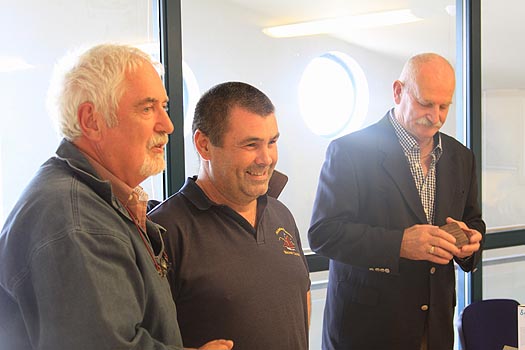
They dreamed the dream, and they made it happen. Key movers in the Naomh Cronan story were Stiophan O Laoire (left) and Paul Keogh, seen here at Poolbeg Y & BC as they come forward to accept a prize on behalf of the crew from Johnny Wedick, Hon. Sec. of the Dublin Bay OGA. Photo: Dave Owens
And between Paddy's house and the sea, beside a little hidden slipway which serves small boats which undertake the risky but rewarding challenge of harvesting Ireland's most fish-filled waters, the restoration project on the Aigh Vie is proving to be a demanding task. So this weekend the Keogh team – precise numbers unknown until everyone checks in this morning – are on site to re-caulk the Aigh Vie in a wild weekend of communal energy.
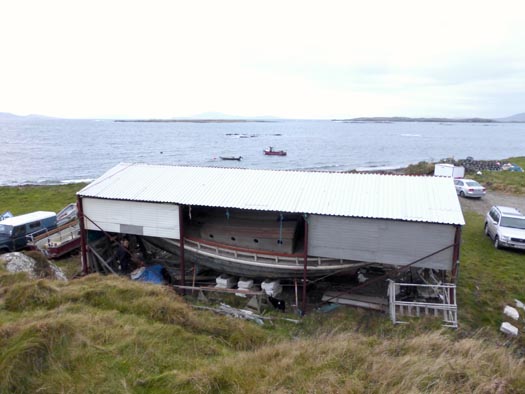
On the Atlantic frontier at Renvyle, the Aigh Vie is under her roof, tilted over to port to facilitate work under the starboard side of the hull. Photo: W M Nixon
For the Aigh Vie is one very special vessel. She's one of the Manx fishing nobbies which reached their ultimate state of development in the first twenty years of the 20th Century before steam power and then diesel engines took over. The nobby evolved to an almost yacht-like form through vessels like the 43ft White Heather (1904), which is owned and sailed under original-style standing lug rig by Mike Clark in the Isle of Man, and the 1910 Vervine Blossom, now based in Kinvara, which was restored by Mick Hunt of Howth, but he gave her a more easily-handled gaff ketch rig which looked very well indeed when she sailed in the Vigo to Dublin Tall Ships Race in 1998.
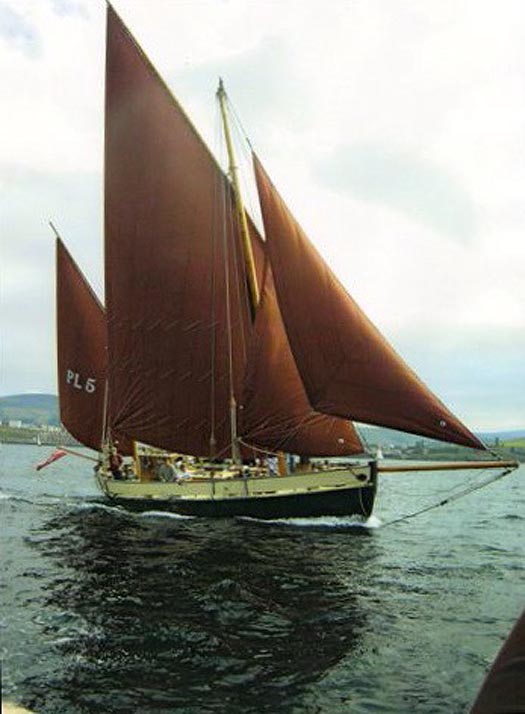
Mike Clark's Isle of Man-based 1904-built Manx nobby White Heather sets the original standing lug rig.
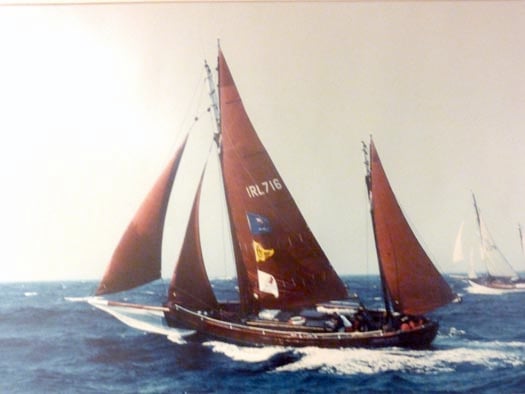
The 1910-built Manx nobby Vervine Blossom was restored by Mick Hunt in Howth, and is seen her making knots under her gaff ketch rig at the start of the 1998 Tall Ships Race from Vigo to Dublin. Photo: David Branigan
It takes quite something to outdo the provenance of these two fine vessels, but the story of Aigh Vie (it means a sort of mix of "good luck" and "fair winds" in Manx) is astonishing. It goes back to the sinking of the Lusitania by a German U Boat off the Cork coast in May 1915, when the first boat to mount a rescue was the Manx fishing ketch Wanderer from Peel, her crew of seven skippered by the 58-year-old William Ball.
They came upon a scene of developing carnage. Yet somehow, the little Wanderer managed to haul aboard and find space for 160 survivors, and provide them with succour and shelter as they made for port. In due course, as the enormity of the incident became clear, the achievement of the Wanderer's crew was to be recognised with a special medal presentation. And then William Ball, who had been an employee of the Wanderer's owner, received word that funds had been lodged with a lawyer in Peel on behalf of one of the American survivors he'd rescued. The money was to be used to underwrite the building of his own fishing boat, to be built in Peel to his personal specifications, and the result was his dreamship, the Aigh Vie, launched in 1916.
Over the years, the Aigh Vie became a much-loved feature of the Irish Sea fishing fleet. Tim Magennis, current President of the Dublin Bay Old Gaffers Association, well remembers her from his boyhood days in the fishing port of Ardglass on the County Down coast. In time, she was bought by the legendary Billy Smyth of Whiterock Boatyard in Strangford Lough, who gradually converted her to a Bermudan-rigged cruising ketch with a sheltering wheelhouse which enabled the Smyth family to make some notable cruises whatever the weather. His son Kenny Smyth, who now runs the boatyard with his brothers and is himself an ace helm in the local 29ft River Class, recalls that the seafaring Smyth family thought nothing of taking the Aigh Vie to the Orkneys at a time when the average Strangford Lough cruiser thought Tobermory the limit of reasonable ambitions.

Aigh Vie as she was when bought by Paddy Murphy from Billy Smyth of Strangford Lough.
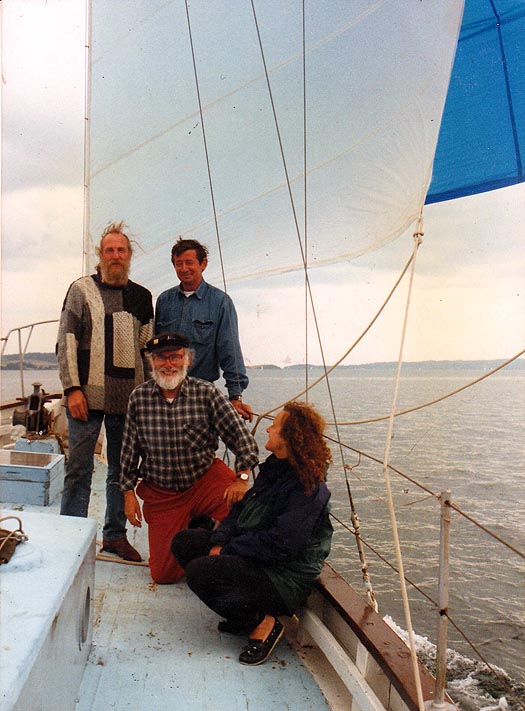
First sail with the newly-bought ship. Aboard Aig Vie heading for Dublin down Strangford Lough, the crew includes Paddy Murphy (left) and Tim Magennis (centre)
It's some years now since Paddy Murphy bought the Aigh Vie, and sailed her back to Dublin with his crew including Tim Magennis. But around the same time, Paddy was moving his base west to Renvyle, where he reckoned his skilled trade as a blacksmith, and his talents in traditional music and folklore, would provide him with a living in the area where he felt most at home.
As for the Aigh Vie, clearly she was reaching an age where work needed to be done. And he was minded to restore her to something more nearly approaching her original 1916 configuration. So somehow or other, he took the big boat west on a truck, managing to negotiate those little winding roads through Tully Cross and down to his place by the sea, where she went under a roof and work began.
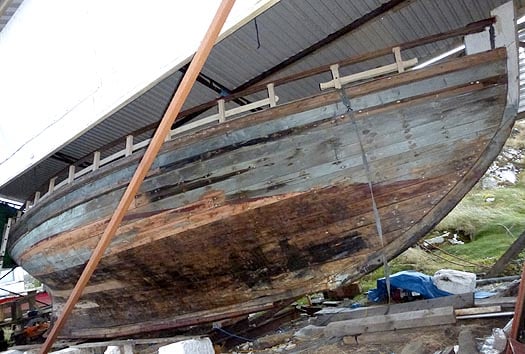
The hull of the 1916-built Aigh Vie as seen in Renvyle shows the remarkably yacht-like lines of the Manx nobby.........Photo: W M Nixon

.........in what was one of the last of the sailing type to be built before steam power took over. Photo: W M Nixon
It has been going on for some time now. The problem with being right on the frontier of Ireland's Atlantic weather is that no sooner do you start on some new area of timber repair and replacement, than the previous restoration section almost immediately starts to become weathered. Working largely on your own, you end up feeling you're going round in circles. So that's why the men from the Naomh Chronan are in Renvyle today to give the Aigh Vie project a mighty push forward.
For there's no doubt that while there's a lot done, there's a lot more still to do. But it does get done eventually if you keep the faith, and I was there back at the beginning of December to cheer Paddy along with all the usefulness of a hurler on the ditch. But at least I was accompanied by Dickie Gomes, who knows a thing or two about long-term boat restoration, as it took him 27 years to bring his 102-year-old Ainmara successfully back to life. But he did it so well that she won the Creek Inn Trophy for "Best in Show" at last summer's Peel Traditional Boat Weekend in the Isle of Man.

A bit of mutual support between two owners of vintage wooden boats – Paddy Murphy and Dickie Gomes in Aigh Vie's shed at Renvyle. Photo: W M Nixon
Nevertheless I've to confess that sometimes I wonder if wood is worth the trouble. Before getting to Renvyle, we'd called by with Jamie Young at Killary Adventure Centre for bit of a love-in with his alloy-built Frers 49 Killary Flyer which - as Brian Buchanan's Hesperia IV - was winner of the Round Ireland Race 1988 under the command of Dickie Gomes. Except that you won't see that fact in histories of the Round Ireland. Because for 1988's race, she sailed as the sponsored entry Woodchester Challenger, and thus was not entitled to the top prize, despite having the best corrected IOR time in the fleet.
But everyone in the know knows that Gomesie won, particularly the crew of Denis Doyle's slightly larger Frers sloop Moonduster. The two boats had been neck and neck running past the Blaskets, and suddenly Hesperia's spinnaker shredded. But Dickie had his crew so well drilled that one half of them had a replacement chute up and drawing before the other half had finished getting in the remains of the torn sail. The boat scarcely missed a beat in her rapid progress, and when the whole business was completed in about three minutes flat, there was a round of applause from Moonduster. You'd sportsmen doing the Round Ireland in those days.
As it happens, one of Hesperia's crew for that neat bit of work was Kenny Smyth, so it made it more than appropriate that we were going on to see the Aigh Vie on which he cut his offshore sailing teeth. But it was good to linger for a while at Jamie's snug place, and marvel at how he, with aid from the ingenious folk of the west, had contrived a slip and an angled trolley so that Killary Flyer can be hauled on site into a sheltered corner, for she's a big lump of a boat to be handling ashore.
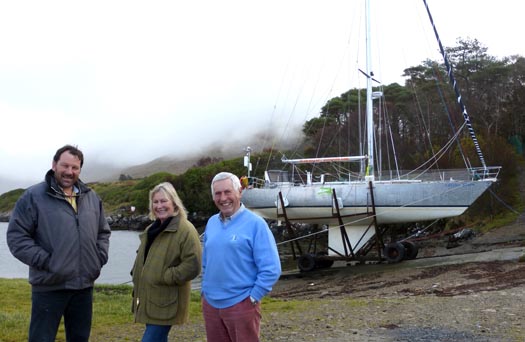
She's a big boat to be hauling on a slip in a remote corner of Mayo. Early December beside Killary Fjord, and Jamie Young of the Adventure Centre with Deirdre and Dickie Gomes and the Frers 49 Killary Flyer ashore for the winter. Deirdre was a fulltime member of the boat's crew when Dickie successfully skippered her offshore as Brian Buchanan's Hesperia IV. Photo: W M Nixon
It was some time in the New Year that we heard the shocking news. One of the most severe storms had twirled the Flyer up like a toy boat from her sheltered corner, and deposited this Frers masterpiece on her ear. Jammed in against the steep shore, she was trapped as the tide came in, and the hull was flooded with severe damage to the electrics and electronics.
But this is the west, where they're accustomed to overcoming massive challenges. The extraordinary Tom Moran of Clew Bay Boats played a key role in a salvage project which saw a temporary road being built so that a giant crane could be positioned for the delicate job of inching the big boat back upright. That done, she could then be moved to Tom's place at Westport for restoration to begin.
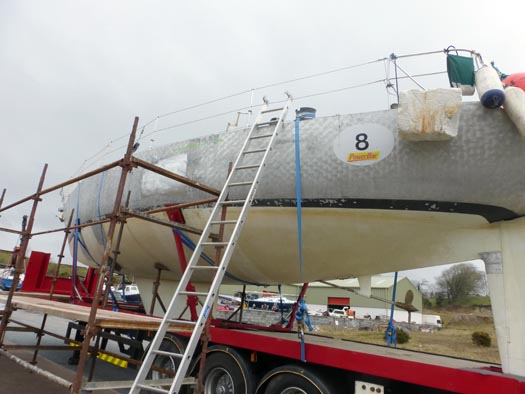
A couple of dents in aluminium? No problem. Following her brief episode of aviation, Killary Flyer's hull is already made good at Clew Bay Boats in Westport. Photo: W M Nixon
The whole business has been a marvellous advertisement for the effectiveness of hull construction using modern marine alloys. When aluminium was first created as the "Metal of the Future" two centuries ago, only the Emperor Napoleon could afford to have a cutlery set made in this exotic stuff. And though an early alloy boat put afloat in Lake Geneva performed reasonably well, as soon as a boat built with it was put into the salty sea, it just melted away.
But over the years the formulas have been adjusted to be corrosion proof in sea water, such that nowadays it's the ideal material for little boats which are going to have hard usage yet little maintenance, such as angling boats and the nippy craft used by rowing coaches.
And if you have a low-maintenance alloy hull yet give it a bit of cosmetic attention, it will look very well indeed, but it's not essential. As for the rough and tumble of life afloat, if you crash into a quay wall with a traditionally built wooden boat, she'll become shook from bow to stern – you never really know where the underlying structural damage ends, if at all. As for GRP and carbon or whatever, the damage will be more localised, but it still gets holed, and messily with it at that, while bulkheads may shift to an unknown degree
But a steel or aluminium hull will generally just be dented, and very locally at that. Repairs are manageable, even if it's skilled specialist work. So there's a lot in favour of steel and alloy. But steel rusts, and it never rusts quicker than in hidden pockets in the structure. But with remarkable advances in alloy welding and building techniques, the advantages of modern corrosion-free alloy construction become more evident every year for boats that are really going to be used, and not just seen as marina ornaments.
The Killary Flyer experience is ultimately a telling argument in favour of alloy construction. The hull was only dented in a couple of places where it was actually in direct contact with outcrops on the foreshore. Any dents have already been repaired by Tom Moran and his team, for they're able for anything to do with boats in any sort of material - I reckon if you wanted to build your dreamship out of resinated peat moss, then Tom would be game for the job.

Can-do people of the west – Mary and Tom Moran of Clew Bay Boats have successfully taken on many marine problems and projects. Photo: W M Nixon
Sorting out the interior systems is going to be more of a challenge, for Hesperia was originally Noryema X, built for Ron Amey in 1975. In a sense, there's a feeling of homecoming in the fact that she's being restored in Westport. If you head directly inland from that lovely little town, you're soon up in the mountains in the Joyce Country. And way back in 1975, the alloy hull of Noryema X was built by the renowned Joyce Brothers. Their fabrication workshop may have been in Southampton, but the family wasn't that long out of the mountains of far Mayo.
However, once the innovative Ron Amey had taken delivery of the hull of his latest Noryema from the brothers Joyce, he then took it to Moody's big shed at Bursledon on the Hamble for completion by the boatyard's craftsmen. I happened to be Bursledon-based in the early summer of 1975, and it really was all a wonder to behold.
Amey had installed a caravan in Moody's shed, and he lived in it while overseeing every detail of the new boat's fitout, while at the same time running his business empire of Amey Roadstone from a telephone in the caravan. It was said that the great man wouldn't be really happy with his new boats until the final jobs were completed just before the Fastnet Race in August, and after that he'd then start to think of the next one. But Noryema X was something special. She became the last of the racing line, and despite her enormous rig, Ron Amey then used her for eleven years of cruising in the Mediterranean which concluded with her sale to Brian Buchanan of Belfast Lough at Marseilles in 1986. She has been based on our island ever since, the source of much seagoing pleasure for hundreds of Irish sailors.
So bringing her back up to Amey standards is quite a challenge, as she's now part of Ireland's sailing heritage. But with Tom Moran they've someone who seems to have links with every maritime specialist in the country, and if he draws a blank in Ireland, his connections around the Solent marine industry seem pretty hot too.

Not quite where you'd expect to find an Arctic voyaging vessel, but Northabout seems at home in the Moylure Canal in the midst off Mayo fields. Photo: W M Nixon
Much encouraged by all this, for Clew Bay Boats is the sort of place where many good things seem possible, we then headed down to the Moylure Canal, a drainage waterway near Rosmoney at the head of Clew Bay where the great Jarlath Cunnane has created a tiny boat harbour and beside it a little place where, if so minded, he can build himself a boat.
Jarlath is the quintessential Connacht mariner, yet you'll never find him being sentimental about wooden boats. On the contrary, in the time I've known him he has built himself a steel van de Stadt 34ft sloop which he cruised very extensively, and more recently he took on the challenge of alloy construction to build the 44ft Northabout. Aboard this special boat, in teamwork with Paddy Barry, he has made cruises to remote and challenging places in voyages which, for most people, would have required full military logistical support.
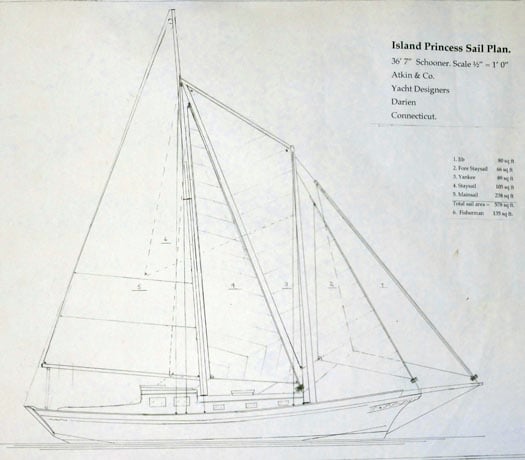
The new dreamship. Plans of the 37ft Atkins schooner which Jarlath Cunnane has been building over four years.
Knowing the scale of what he has done with her, it was bizarre to see Northabout sitting modestly in her berth in the little creek beside a Mayo field. But the presence of the long distance high latitude voyager was only part of the Moylure package. A few feet away in "the shed which isn't really a shed" was the new Cunnane boat, a sweet 37ft–Atkins schooner which, if you haven't yet appreciated the potential of good alloy boat construction, would surely win you over in a trice.

Good alloy construction, as seen here in the stemhead of the new schooner, can withstand comparison with any material. Photo: W M Nixon
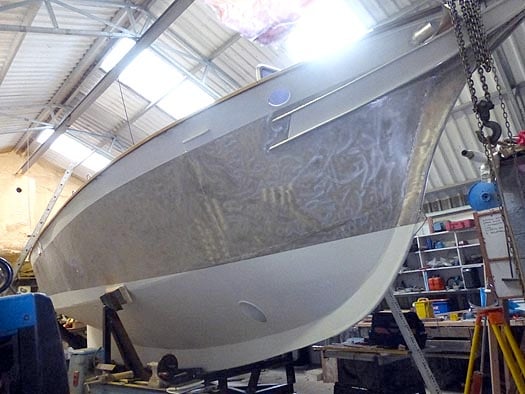
The new schooner has a workmanlike and handsome hull......Photo: W M Nixon

....which is aimed for comfort as much as speed, but she should be able to give a good account of herself in performance, and will be very comfortable for longterm periods on board. Photo: W M Nixon
Jarlath has taken four years on the construction, and when he gets to sailing the new boat, I'd say that the motto will be: "When God made time, he made a lot of it". This is a boat for leisurely cruising, a boat to enjoy simply being on board. In her finished state, she'll give little enough in the way of clues as to her basic construction material. Like Killary Flyer, and like Northabout too, she is in her own way a great advertisement for the potential of good alloy construction.
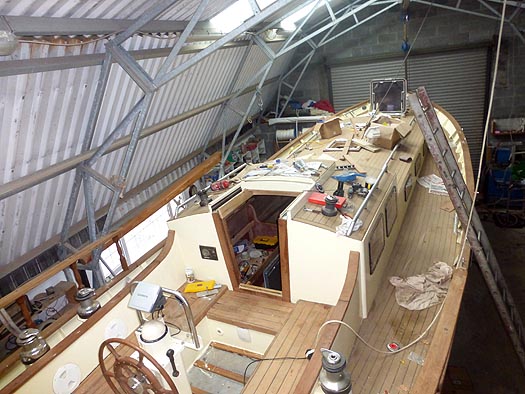
As completion nears, it becomes ever less apparent......Photo: W M Nixon
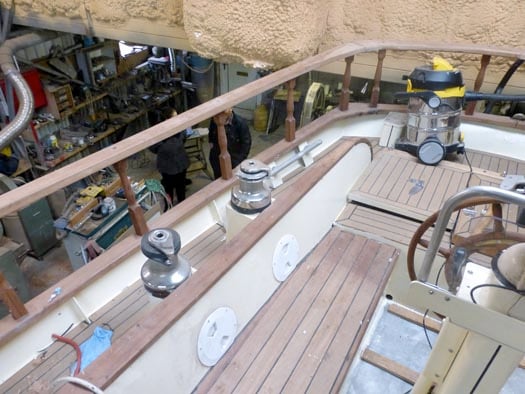
.....that the hull construction of the new schoner is in aluminium. Photo: W M Nixon
So we'll sign off this week with a special thought. As Irish life begins to move again, doubtless we'll soon hear increasing mutterings about the desirability of building a new Asgard sail training brigantine. Maybe we should keep the government out of it this time round, and build her through a voluntary trust organisation supported by public subscriptions and corporate donations. But however it's to be done, we should be starting to think about it.
And like many others, I've long thought that the ideal way forward would be with a steel hull built to Jack Tyrell's original Asgard II lines, which have a magnificently timeless quality to them. But I've changed my mind on that. Having seen what can be done with good alloy construction down in Mayo, and knowing the quality of alloy workboat construction being produced by firms like Mevagh Boatyard in Donegal and by the descendants of Jack Tyrrell among others at Arklow Marine Services in County Wicklow, it's difficult to escape the conclusion that the hull of the new ship should be built in aluminium.
It would be initially expensive, but it would confer great longterm maintenance advantages. And by going that way, we'd be able to provide all the double skins and safety bulkheads which will now be required without using up all available hull space, and without producing a boat so heavy she wouldn't be able to sail out of her own way. So let's hear it for an aluminium-hulled Asgard III.
Irish Sailor Wins Ocean Award for Voyage from Mayo to Russia
#cruising – Irish sailor Jarlath Cunnane has been awarded the prestigious Vasey Vase trophy by the The Ocean Cruising Club (The OCC) at its awards ceremony in London last night. The top prize in world cruising achievements is for the Mayo man's unusual and exploratory voyage through the White Sea Canal through Russia and around Scandinavia.
Jarlath and crew aboard his sailing vessel Northabout set out from Westport, Ireland for a journey to St. Petersburg and through the Belomorsk Canal into the White Sea. Northabout logged over 4500 miles in this adventure. She passed through 6 canals and river systems en route, including 115 locks.
Partly because of the difficulty normally inherent in making this transit as Prime Minister Putin had put severe restrictions on transit by any but government authorized transport vessels, few pleasure vessels have made this journey. In fact Northabout had planned to take that route after their successful transit of the Northeast Passage in 2004-2005 but were denied permission. As restrictions were somewhat eased, Jarlath made the decision to try again.
It was a most unusual journey to the Gulag Archipelago which included a visit to Sandermark, a burial ground where 7000 of Stalin's victims were laid to rest in mass graves. The canal itself, built by Gulag prisoners, was never the engineering marvel that Stalin envisioned. But it is a short cut that allows passage from the Baltic to the White Sea without the long journey through the Arctic Ocean. This voyage both unusual and exploratory is reflective of the spirit of the Vasey Vase.
Jarlath Cunnane, retired construction manager, boat builder and adventurer from Castlebar, County Mayo, Ireland, is currently building a new boat
Each year the OCC recognises the achievements of ordinary individuals doing extraordinary things on the world’s oceans and brings those achievements to the attention of the sailing community at large.
The OCC Awards Sub-Committee made the announcement at the annual OCC London Boat Show dinner. This year, the recipient of the club’s premier award for members, The Barton Cup, is Jeanne Socrates, who at the age of 70 is the oldest woman to circumnavigate the world solo, non-stop.
Two recipients share the OCC Award of Merit, an OCC award that recognises both members and non-members: Herb Hilgenberg and Laura Dekker. Herb assisted blue water sailors with ship-routing and weather advice for more than 25 years. Laura has shown the world that being the youngest circumnavigator was not derived from seeking fame and fortune but rather from a tremendous passion for sailing.
Commodore John Franklin added, “I congratulate all award recipients and nominees, and I thank all adventurous cruising sailors for inspiring new generations to reach for extraordinary goals.” All winners are invited to attend the OCC Annual Dinner and Awards Ceremony on 12th April 2014 aboard HQS Wellington (Head Quarters Ship and home of the Honourable Company of Master Mariners) in London, where formal presentations of the awards will be made. The full stories will be presented on the night and published in the subsequent edition of Flying Fish (the journal of the Ocean Cruising Club).
The full OCC press release is available to download below.
Irish Cruising Club Present Fastnet Award to Killian Bushe
So whenever a high-powered strongly-resourced international challenge is taking shape, Bushe is the boat-builder of choice, favoured by leading designers and top skippers alike. But if you have a challenge in mind and he is top of the list, please join the queue.
For at the moment, he is immersed as leading consultant in building the new Groupama 4, the top French Volvo 70 for Franck Cammas. Before that, he built the two successful Ericsson boats for the last Volvo – they took first and fourth. In fact, he has built the overall winners of the last three Volvo races. And when Groupama 4 is launched in May and signed off for the race (which starts on October 29th) Bushe returns his focus to Sweden which is now his home, where he has been involved with the Artemis challenger for the America's Cup 2013.
For that project, the designer is Juan Kouyoumdjian, and the skipper is Paul Cayard. This is stratospheric stuff, but that's the level where Bushe operates. With more than thirty years of high tech boat building experience, and a string of success that is mind-boggling, he is the gold standard. But beyond that, he is still the Crosshaven kid who started his racing on his father George's Avocet (which George designed and built), and internationally he is the spirit of Cork sailing.
His renowned skill and knowledge in the use of advanced materials and composites is such that you'd expect him to be awarded a Honorary Doctorate in chemistry from some appropriate university. But in the meantime, his special place in Irish and world sailing was honoured on Saturday March 26th with his award of the Fastnet Trophy.
This trophy is co-ordinated by the Irish Cruising Club, and it operates in very broad brief. Initiated in 2005 with its first award to Paddy Barry and Jarlath Cunnane for their pioneering circuit of the Arctic via both the Northwest Passage and the Northeast Passage, its unique lineage has been maintained by such awardees as Robin Knox-Johnston, and the most recent one, centenarian circumnavigator Bill King of Galway.
The Fastnet Trophy is envisaged as highlighting a contribution to sailing which has a sense of the unique about it, and Killian Bushe is just the man. His international sailing achievements began back in 1976 when he was one of the crew that won the Half Ton Cup at Trieste in the Cork-built Silver Shamrock. They celebrated by sailing up the Grand Canal in Venice with spinnaker set. But gradually the boat-building took over, though Bushe sails with his family in Sweden whenever he can. That is what was being celebrated on Saturday night. Killian Bushe – very good sailor, extremely good boatbuilder.




























